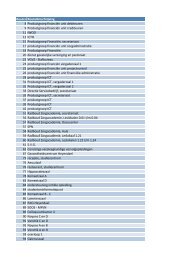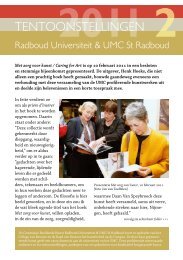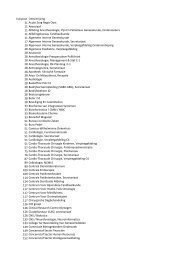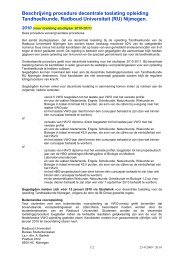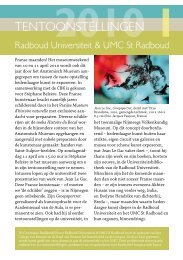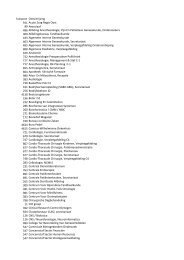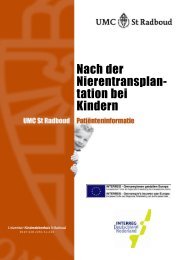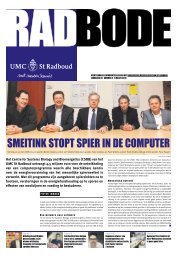Neuralgic Amyotrophy: idiopathic and hereditary ... - UMC St Radboud
Neuralgic Amyotrophy: idiopathic and hereditary ... - UMC St Radboud
Neuralgic Amyotrophy: idiopathic and hereditary ... - UMC St Radboud
You also want an ePaper? Increase the reach of your titles
YUMPU automatically turns print PDFs into web optimized ePapers that Google loves.
all necessary. Learning how to carry out a movement with the correct timing of<br />
muscle tightening <strong>and</strong> relaxing is important (muscle coordination training). Often,<br />
too much thought is given to the muscle weakness <strong>and</strong> the strengthening of the<br />
muscles <strong>and</strong>, in the therapy, one ‘forgets’ that tightening must be alternated with<br />
relaxation.<br />
3. Late phase (residual symptoms)<br />
Factors that maintain the symptoms<br />
Approximately two thirds of the NA patients who were examined at the <strong>UMC</strong><br />
<strong>St</strong>. <strong>Radboud</strong> had, after a few weeks to months, severe pain in the area surrounding<br />
the shoulder blade, the neck <strong>and</strong> the back of the head. This was caused by<br />
overexertion of both the weakened <strong>and</strong> the compensating muscles. Moreover,<br />
pain <strong>and</strong> reduced mobility in the shoulder joint are common. This is caused by the<br />
different way of moving the shoulder joint because a number of the muscles that<br />
control this joint are reduced in strength. The joint thus becomes – both in rest<br />
<strong>and</strong> during movement – unbalanced. Because of this, the movement between the<br />
socket joint of the shoulder (glenoid) <strong>and</strong> the ball of the shoulder is no longer fluid<br />
<strong>and</strong> the tendons <strong>and</strong> muscles surrounding the shoulder can become pinched <strong>and</strong><br />
damaged.<br />
Treatment of the above symptoms is not easy, certainly not if they have been<br />
going on for months or are getting worse. Often, NA patients get caught up in<br />
a negative spiral in which, for example, the pain increases so that the patient is<br />
forced to rest until the pain subsides, <strong>and</strong> then the patient again takes on all sorts<br />
of activities that, once again, lead to pain. The first step in the approach to these<br />
on-going symptoms is to determine what factors play a role in the patient’s life in<br />
maintaining that vicious circle.<br />
Four factors can be differentiated that keep the pain <strong>and</strong> restrictions going in<br />
patients with NA.<br />
24<br />
Physical factors<br />
First of all, there is the physical factor: strength <strong>and</strong> sensation in the individual<br />
muscles <strong>and</strong> their recovery (‘hardware’). What is important here is that the nerve<br />
recovery leads to a muscle that can be controlled again, but that this, at the same<br />
time, is at the expense of the possibility of the muscle to persevere <strong>and</strong> keep up<br />
a certain movement or contraction. You will notice that you can carry out a certain<br />
movement a couple of times, but that the arm then quickly becomes heavy, tired<br />
<strong>and</strong> less strong <strong>and</strong> that moving it becomes increasingly difficult.<br />
Way of moving<br />
The following factor is the way of moving that the entire body uses to carry out<br />
tasks. Shoulder movements dem<strong>and</strong> an extremely complex control (the ‘software’)<br />
from the brain. This happens, for the most part, unconsciously.<br />
If there is damage to the hardware, the body immediately shifts to another way<br />
of steering (a compensation strategy) so that the position or movement can still<br />
be carried out as well as possible. For example, you might find that in order to<br />
reach above shoulder hight your body is pulling the shoulder very close <strong>and</strong> you<br />
lean over with your trunk to get the h<strong>and</strong> up where it needs to be. This compensation<br />
strategy, however, costs more energy than the normal way of moving. The<br />
movement will, therefore, work at first but often cannot be maintained for long <strong>and</strong><br />
ultimately leads to overburdening.<br />
The load/capacity ratio<br />
The third factor by which the symptoms are maintained is the ratio between the<br />
load <strong>and</strong> the capacity in daily life <strong>and</strong> work (or school/training). Because nerve<br />
recovery takes so long (several months to a few years), NA patients often want,<br />
nonetheless, to get back to their tasks again at home <strong>and</strong> at work as well as possible.<br />
This also depends, of course, on other circumstances, such caring for a<br />
partner or children, or an employer’s dem<strong>and</strong>s. It is better for the muscles affected<br />
by NA to change position often during work <strong>and</strong> to alternate the weight of the load;<br />
also, take frequent short breaks or do something else for a short while (“minibreaks”).<br />
In the daily situation of many people, such flexibility in their schedule is<br />
often hardly possible – or only with a great deal of adjustment (also from others).<br />
A common problem is then that patients, because of these external circumstanc-<br />
25



